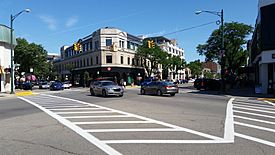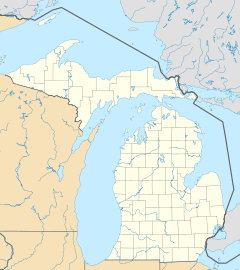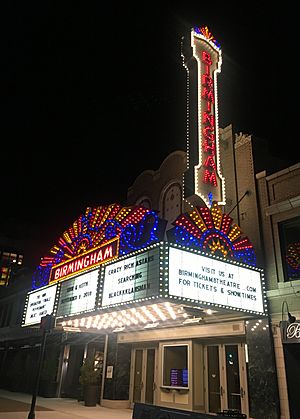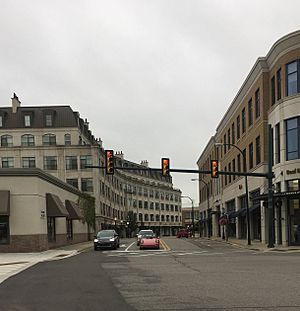Birmingham, Michigan facts for kids
Quick facts for kids
Birmingham, Michigan
|
|
|---|---|
| City of Birmingham | |

Maple Road and Old Woodward Avenue
|
|
| Motto(s):
"A Walkable Community"
|
|

Location within Oakland County
|
|
| Country | United States |
| State | Michigan |
| County | Oakland |
| Settled | 1819 |
| Incorporated | 1864 (village) 1932 (city) |
| Government | |
| • Type | Council–manager |
| Area | |
| • City | 4.81 sq mi (12.45 km2) |
| • Land | 4.79 sq mi (12.42 km2) |
| • Water | 0.01 sq mi (0.03 km2) |
| Elevation | 778 ft (237 m) |
| Population
(2010)
|
|
| • City | 20,103 |
| • Estimate
(2019)
|
21,389 |
| • Density | 4,460.69/sq mi (1,722.17/km2) |
| • Metro | 4,296,250 (Metro Detroit) |
| Time zone | UTC-5 (EST) |
| • Summer (DST) | UTC-4 (EDT) |
| ZIP code(s) |
48009, 48012
|
| Area code(s) | 248 |
| FIPS code | 26-08640 |
| GNIS feature ID | 0621444 |
Birmingham is a city in Oakland County in the U.S. state of Michigan. It is a northern suburb of Detroit located along the Woodward Corridor (M-1). As of the 2010 census, the population was 20,103.
Contents
History
The area comprising what is now the city of Birmingham was part of land ceded by Native American tribes to the United States government by the 1807 Treaty of Detroit. However, settlement was delayed first by the War of 1812 and subsequently by an unfavorable report by the Surveyor-General of the United States, Edward Tiffin, regarding the placement of Military Bounty Lands for veterans of the War of 1812. Tiffin's report claimed that "There would not be an acre out of a hundred, if there would be one out of a thousand that would, in any case, admit cultivation." In 1818, Territorial Governor Lewis Cass led a group of men along the Indian Trail. The governor's party discovered that the swamp was not as extensive as Tiffin had supposed. Not long after Cass issued a more encouraging report about the land, interest quickened in its suitability for settlement.
The earliest land entry was made on January 28, 1819, by Colonel Benjamin Kendrick Pierce (brother of future U.S. President Franklin Pierce) for the northwest quarter of section 36. Colonel Pierce visited his land several times, but never settled on it. In March 1818, John W. Hunter and his brother Daniel left Auburn, New York, by sleigh and traveled to Michigan by way of Upper Canada. They waited in Detroit for their father and other family members who arrived by schooner over Lake Erie in July. The family remained in Detroit until spring 1819 when John W. made an entry for the northeast quarter of section 36, now in the southeast section of current-day Birmingham. Lacking a proper land survey, John W. mistakenly built his log house on a tract later purchased by Elijah Willets. That house was later occupied by William Hall, a son-in-law of Elisha Hunter, while John W. Hunter built another log house a short distance to the southeast. On September 25, 1821, Elijah Willets made a land entry for the southwest quarter of section 25. Two days later, Major John Hamilton made an entry for the southeast quarter of section 25. Each of these initial land entries met at what is now the intersection of Maple Road and Pierce Street.
For a time, all three men, John W. Hunter, Major Hamilton, and Elijah Willets, operated hotels and taverns from their houses within a short distance from each other. While Hunter did not continue for very long, Hamilton and Willets continued a rivalry for many years, competing with each other for business from travelers on Woodward Avenue between Detroit and Pontiac. The growing settlement was known variously as "Hamilton's", "Hunter's", or "Willets'"; it was later known as "Piety Hill". The settlement's original plat was surveyed and recorded on August 25, 1836, in the northwest quarter of section 36 then owned by Rosewell T. Merrill who also ran the town foundry and the thrashing machine factory. Merrill named his plat "Birmingham" after Birmingham, England, in the hope that the new settlement would similarly become a great industrial center. Elijah Willets recorded a plat on his property on December 20, 1837. John W. Hunter followed suit with two plats on his property on January 31, 1840, and June 21, 1842, while Major Hamilton laid out a plat on October 7, 1846. Several other properties were subsequently platted as additions. The plats made in 1836 and 1837 were in anticipation of completion of the Detroit and Pontiac Railroad.
Now known as "Birmingham", the village first received mail through the "Bloomfield" post office. Birmingham established its own post office on April 5, 1838. The settlement incorporated as a village in 1864, comprising the northern half of section 36 and the southern half of section 25 with a total land area of one square mile. The first village elections were held March 1, 1864, and it was soon governed by a seven-man board of trustees who appointed a marshal and a treasurer. Birmingham re-incorporated as a city in 1933. Prior to this the area just north of 14 Mile along Woodward was known as 'Eco City.
The names of the city's founders are seen throughout Birmingham in places such as Pierce Elementary School, Hunter House Hamburgers (which was located on the road formerly known as Hunter Boulevard, which bypassed downtown to the east and was renamed Woodward, with the original Woodward Avenue section renamed Old Woodward), the Hamilton Hotel, the Willets Building and Merrill Street. Hall & Hunter Realtors named themselves in tribute to the builder and occupier of Birmingham's first home.
Geography
According to the United States Census Bureau, the city has a total area of 4.80 square miles (12.43 km2), of which 4.79 square miles (12.41 km2) is land and 0.01 square miles (0.03 km2) is water.
Demographics
| Historical population | |||
|---|---|---|---|
| Census | Pop. | %± | |
| 1880 | 733 | — | |
| 1890 | 899 | 22.6% | |
| 1900 | 1,170 | 30.1% | |
| 1910 | 1,607 | 37.4% | |
| 1920 | 3,694 | 129.9% | |
| 1930 | 9,539 | 158.2% | |
| 1940 | 11,196 | 17.4% | |
| 1950 | 15,467 | 38.1% | |
| 1960 | 25,525 | 65.0% | |
| 1970 | 26,170 | 2.5% | |
| 1980 | 21,689 | −17.1% | |
| 1990 | 19,997 | −7.8% | |
| 2000 | 19,291 | −3.5% | |
| 2010 | 20,103 | 4.2% | |
| 2020 | 21,813 | 8.5% | |
| U.S. Decennial Census | |||
2010 census
As of the census of 2010, there were 20,103 people, 9,039 households, and 5,307 families living in the city. The population density was 4,196.9 inhabitants per square mile (1,620.4/km2). There were 9,979 housing units at an average density of 2,083.3 per square mile (804.4/km2). The racial makeup of the city was 92.3% White, 3.0% African American, 0.1% Native American, 2.5% Asian, 0.4% from other races, and 1.6% from two or more races. Hispanic or Latino of any race were 2.1% of the population.
There were 9,039 households, of which 29.8% had children under the age of 18 living with them, 48.4% were married couples living together, 7.6% had a female householder with no husband present, 2.7% had a male householder with no wife present, and 41.3% were non-families. 36.2% of all households were made up of individuals, and 10.8% had someone living alone who was 65 years of age or older. The average household size was 2.22 and the average family size was 2.96.
The median age in the city was 41.1 years. 24.6% of residents were under the age of 18; 3.9% were between the ages of 18 and 24; 27.7% were from 25 to 44; 30.1% were from 45 to 64; and 13.7% were 65 years of age or older. The gender makeup of the city was 48.1% male and 51.9% female.
Arts and culture
The First United Methodist Church was established in 1821 with its first services conducted in Elijah Willits' tavern. Its current location was built in 1839; it is now the oldest church building in the city. Currently, there are other houses of worship spanning many different religions.
George H. Mitchell and Almeron Whitehead, who were two of a small group of bachelors who had formed a club called The Eccentrics, published the first edition of their newspaper which they named after their club on May 2, 1878. At a price of 2 cents, The Eccentric provided a "live home paper, replete with all the news of the day" with considerable emphasis on the "local items of importance occurring in Birmingham and immediate vicinity". By the turn of the 20th century, The Eccentric ran advertisements for Detroit stores and theaters as well as offers of property and houses suitable for the "commuter". In the 1920s, the slogan of The Eccentric was "For a Bigger and Better Birmingham". Today, the Birmingham Eccentric newspaper continues its role as keeper of the community's local heritage.
In 1923, a group of friends formed The Village Players of Birmingham, a private theater club. Originally, performances were given in the community house, then in 1928 the group built their own theater just outside the downtown area. Today this all-volunteer group is open to everyone and puts on five shows each year. The community house is a spacious facility with a New England ambiance. Many new churches have started at this location, including the Bloomfield Hills Christian Church was pioneered during the late 1970s by the Ninowskis. The church has grown and moved to a number of different locations over the years, and the son, Joe Jr Ninowski, continues in full-time ministry with strong connections to spiritual celebrities such as Joni Erickson - Lamb. Joe Jr lost his father in a fatal plane crash while his father, Joe Ninowski Sr. was serving the church at the community center in the late 1970s.
In 2008, the Birmingham Little League won the 9- to 10-year-old Little League state championship. The team beat Western Little League 12–5 to earn the title.
Parks and recreation
The city has over twenty parks with many amenities including tennis courts, baseball diamonds, playgrounds, golf courses, sledding hills, nature trails, picnic areas and deep woods. Shain Park, the city's main commons, is the site of the Village Fair, art shows, summer music concerts and numerous community events all beneath The Freedom of the Human Spirit sculpted by Marshall Fredericks.
Education
The Birmingham City School District administers several nationally accredited schools including Seaholm High School and Groves High School. Roeper School has a campus on Adams Road. The Holy Name School is a co-educational parochial school founded by the Roman Catholic Holy Name Church. It educates children grades pre-K to 8. The school was established in 1928, along with a now non-existent convent for IHM nuns. The church and school continue to operate in conjunction today.
Pierce Elementary School in Birmingham provides classes for elementary school students of the French School of Detroit.
The Japanese School of Detroit (JSD), a supplementary school for Japanese citizens, first began holding classes in Birmingham in 1987 when its operation at Seaholm High started. It began holding classes at Covington School in 1989, and it also had classes at West Maple Elementary. At one point its school offices were in Birmingham. In 2010 the school announced it was moving its operations to Novi.
Public library
The Baldwin Public Library serves the city of Birmingham and nearby communities of Beverly Hills, Bingham Farms and Bloomfield Hills. The original building first opened to the public on December 19, 1927. In October 1959, an extension for the Youth Department was added to the east side of the building. In 1983, another addition opened, changing the entrance to Merrill Street. There are over 120,000 books in the library, along with CDs, DVDs, periodicals, educational toys, databases and free Wi-Fi.
The library is named after Martha Baldwin, a civic leader and lifelong resident of Birmingham who was instrumental in establishing the first library. She also helped get sidewalks for the business section, street lights, seats placed at interurban transit stops, flowers and trees planted and wastebaskets placed at the street corners.
Infrastructure
Transportation
Birmingham was a stagecoach stop in the 19th century between Detroit and Pontiac. In 1839, the railroad tracks were extended to Birmingham with two steam trains a day running to Detroit.
On June 18, 1896, the Oakland Railway, the electric interurban, was constructed to Birmingham; it provided service to Detroit in 40 minutes. This service ended in 1931 as many passengers switched to the commuter rail and automobiles.
Amtrak provides long-distance passenger rail service on the Pontiac–Detroit–Chicago Wolverine. It stops in Birmingham three times per day in each direction at the Birmingham, Michigan Amtrak station. Class one freight rail service is provided by Canadian National Railway (CN).
By 1931, the Grand Trunk Western Railroad (GTW) moved the railroad tracks to their present location. It provided commuter rail service from Pontiac to downtown Detroit with a stop in Birmingham. The Southeastern Michigan Transportation Authority (SEMTA) took control of this service in 1974 but it was ended on October 17, 1983, after subsidies were discontinued. Efforts continue to this day to restore such service.
In the 21st century, the Suburban Mobility Authority for Regional Transportation (SMART) and the Regional Transit Authority (RTA) operate local and regional bus transit.
Notable people
- Tim Allen, actor (raised in Birmingham)
- Shane Battier, basketball player for four NBA teams
- Mike Binder, film director, screenwriter and actor
- Randal Bryant, dean, Carnegie Mellon School of Computer Science
- Elaine Crosby, pro golfer
- Patricia Ellis, 1930s film actress, born in Birmingham
- Virgil Exner, automobile designer
- Marshall Fredericks, sculptor
- Wallace Frost, architect
- Pat Gillick, Baseball Hall of Famer
- Clarence Dayton Hillman, businessman
- Laura Innes, actress (attended Seaholm High School)
- Calvin Johnson, former NFL wide receiver
- Christine Lahti, Emmy-winning, Oscar-nominated actress
- Alexi Lalas, former pro soccer player
- Anita Lo, restaurateur
- Kurt Luedtke, journalist and Oscar award-winning screenwriter
- Michael J. Malik Sr., businessman
- Alonzo L. McDonald business man and philanthropist
- Gerald S. McGowan, US ambassador to Portugal
- Ruth McNamee, Michigan state legislator and Mayor of Birmingham
- Steve Morrison, pro football linebacker
- Meg Oliver, anchor of CBS's Up to the Minute
- Mike Posner, singer
- Sam Raimi, film director (attended Groves High School)
- Andy Roeser, former president of NBA's Los Angeles Clippers
- Kurt Schottenheimer, former NFL assistant coach
- Alexandra Silber, actor and singer
- David Spade, actor and comedian
- Paul Stookey, member of the trio Peter, Paul, and Mary
- Elaine Stritch, actress and vocalist
- Tom Tjaarda, automobile designer (attended Seaholm High School)
- Tom Tracy, pro football running back
- Dave Trott, US congressman
- Florence Signaigo Wagner (1919–2019), botanist who served as president of the American Fern Society
- Sheila Young, speed skater and track cyclist
Images for kids
See also
 In Spanish: Birmingham (Míchigan) para niños
In Spanish: Birmingham (Míchigan) para niños










